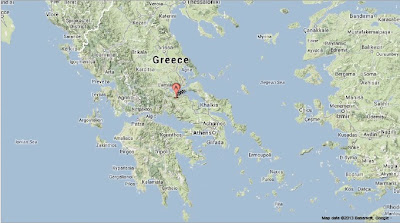On Monday 16 September 2013, slightly after 5.40 pm local time (slightly after 2.40 pm GMT) the United States Geological Survey recorded a Magnitude 4.8 Earthquake close to the surface in Phthiotis, Central Greece. This was followed by a second quake in the same area slightly after 6.00 pm local time (slightly after 3.00 pm GMT), this time a Mgnitude 5.3 at a depth of 7.7 km. These were fairly large events, and were felt as far away as Athens, roughly 120 km to the southeast, but there are no reports of any damage or casualties.
The approximate location of the 16 September 2013 Phthios Earthquakes. Google Maps.
Southern Greece and Turkey lie on the boundary between the Eurasian and African Plates on two smaller plates, the Aegean Sea Plate (underlying the Peloponnese, Attica, The Cyclades Islands, Crete, the Dodecanese Islands and Turkey to the southeast of the Taurus Mountains) and the Anatolian Plate (underlying most of the rest of Turkey). Northern Greece and the north coast of Turkey lie on the Eurasian Plate. Both countries are highly prone to earthquakes because of this.
The Aegean Sea Plate is moving southwest with regard to the Eurasian and Anatolian Plates, and being subducted beneath the African Plate to the south. Its margin with the Eurasian Plate is a divergent and a transform margin at different points. Beneath the Phthiotis it is both a divergent, where the plates are moving apart, and a transform margin where they are moving past one-another laterally. This is not a smooth process, with rocks tending to stick together, then being forced to move as the pressure builds up, typically in stops and starts that lead to Earthquakes.
See also Magnitude 4.5 Earthquake under the Ionian Sea, Magnitude 4.6 Earthquake in western Romania, Magnitude 4.3 Earthquake in northwest Turkey, Magnitude 4.1 Earthquake in northeast Turkey and Magnitude 4.1 Earthquake in Montenegro.
Follow Sciency Thoughts on Facebook.

